Abstract
Integration of migrants and their descendants is a common concern among countries with a long history of immigration. In Australia, this found expression in restrictive immigration policies that limited the entry of non-Europeans until the 1940s. This was based on the strong belief that national unity and social cohesion were contingent on maintaining ethnic and racial homogeneity (Jupp, 2007; Markus et al., 2009). However, spurred by an expanding manufacturing sector in postwar years and concerns about national security, Australia opened its doors to migrants from Southern and Eastern Europe. This was followed in the 1970s by a large inflow of migrants from the Middle East, in particular from Lebanon and Turkey. Migration from Asia, in particular from East Asia, Southeast Asia, and South Asia, has been a major contributor to Australia’s migration program since the 1980s.
Access this chapter
Tax calculation will be finalised at checkout
Purchases are for personal use only
Preview
Unable to display preview. Download preview PDF.
References
Alba, R. (1995). “Assimilation’s quiet tide,” The Public Interest 119(1): 3–18.
Alba, R. and Nee, V. (2003). Remaking the American Mainstream: Assimilation and Contemporary Immigration, Cambridge, MA: Harvard University Press.
Borrie, W. D. (1954). “New and Old Australians,” in Aughterson, W. V. (ed.) Taking Stock: Aspects of Mid-Century Life in Australia, Melbourne: F.W. Cheshire, pp. 167–186.
Borrie, W. D. (1959). The Cultural Integration of Immigrants, Paris: UNESCO.
Clyne, M. (2011). “Multilingualism, multiculturalism and integration,” in Clyne, M. and Jupp, J. (eds) Multiculturalism and Integration: A Harmonious Relationship, Canberra: ANU e Press, 73–88.
Clyne, M. and Kipp, S. (1995). “The extent of community language maintenance in Australia,” People and Place 3(4): 4–8.
Giorgas, D. and Jones, F. L. (2002). “Intermarriage patterns and social cohesion among first, second and later generation Australians,” Journal of Population Research 19(1): 47–64.
Gray, A. (1987). “Intermarriage: Opportunity and preference,” Population Studies 41: 365–379.
Heard, G., Khoo, S.-E., and Birrell, B. (2009). “Intermarriage by religion in Australia,” People and Place 17(2): 43–55.
Jones, F. L. (1991). “Ethnic intermarriage in Australia, 1950–52 to 1980–82: Models or indices?,” Population Studies 45: 27–42.
Jones, F. L. and Luijkx, R. (1996). “Post-war patterns of intermarriage in Australia: The Mediterranean experience,” European Sociological Review 12(1): 67–86.
Jupp, J. (2007). “The quest for harmony,” in Jupp, J. and Nieuwenhuysen, J. (eds) Social Cohesion in Australia, Melbourne: Cambridge University Press, 9–20.
Karidakis, M. and Arunachalam, D. (2015). “Shift in the use of migrant community languages in Australia,” Journal of Multilingual and Multicultural Development. DOI: 10.1080/01434632.2015.1023808.
Kipp, S., and Clyne, M. (2003). “Trends in the shift from community languages: Insights from the 2001 Census,” People and Place 11(1): 33–41.
Khoo, S.-E. (1995). “Language maintenance amongst the second generation,” People and Place 3(4): 9–12.
Khoo, S.-E. (2004). “Intermarriage in Australia: Patterns by ancestry, gender and generation,” People and Place 12(2): 34–43.
Khoo, S.-E., Birrell, B. and Heard, G. (2009). “Intermarriage by birthplace and ancestry in Australia,” People and Place 17(1): 15–27.
Markus, A., Jupp, J. and McDonald, P. (2009). Australia’s Immigration Revolution, Crown Nest, NSW: Allen & Unwin.
McCaa, R. (1989). “Isolation or assimilation? A log linear interpretation of Australian marriages, 1947–60, 1975, and 1986,” Population Studies 43: 155–162.
Penny, J. and Khoo, S.-E. (1996). Intermarriage: A Study of Migration and Integration, Canberra: Commonwealth of Australia.
Piller, I. (2012). “Multilingualism and social exclusion,” in Martin-Jones, M., Blackledge, A. and Creese, A. (eds) The Routledge Handbook of Multilingualism, Hoboken, NJ: Taylor and Francis, 281–296.
Piller, I. and Takahashi, K. (2011). “Linguistic diversity and social inclusion,” International Journal of Bilingual Education and Bilingualism 14(4): 371–381.
Price, C. (1982). The Fertility and Marriage Patterns ofAustralia’s Ethnic Groups, Canberra: Department of Demography, Australian National University.
Price, C. (1993). “Ethnic intermixture in Australia,” People and Place 1(1): 6–8.
Price, C. and Zubrzycki, J. (1962a). “The use of inter-marriage statistics as an index of assimilation,” Population Studies 16(1): 58–69.
Price, C. and Zubrzycki, J. (1962b). “Immigrant marriage patterns in Australia,” Population Studies 16(2): 123–133.
Rivett, K. (1962). Immigration: Control or Colour Bar?, Melbourne: Melbourne University Press.
Walker, L. and Heard, G. (2015). “Interethnic partnering: Patterns by birthplace, ancestry and Indigenous status,” in Heard, G. and Arunachalam, D. (eds) Family Formation in 21st Century Australia, Dordrecht, The Netherlands: Springer, pp. 53–76.
Editor information
Copyright information
© 2016 Dharma Arunachalam and Maria Karidakis
About this chapter
Cite this chapter
Arunachalam, D., Karidakis, M. (2016). Intermarriage, Language Use, and Integration of Migrants. In: Healy, E., Arunachalam, D., Mizukami, T. (eds) Creating Social Cohesion in an Interdependent World. Palgrave Macmillan, New York. https://doi.org/10.1057/9781137520227_9
Download citation
DOI: https://doi.org/10.1057/9781137520227_9
Publisher Name: Palgrave Macmillan, New York
Print ISBN: 978-1-349-70500-9
Online ISBN: 978-1-137-52022-7
eBook Packages: Social SciencesSocial Sciences (R0)

